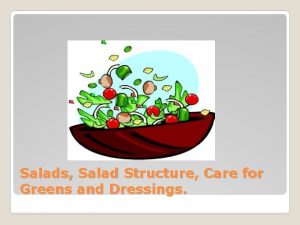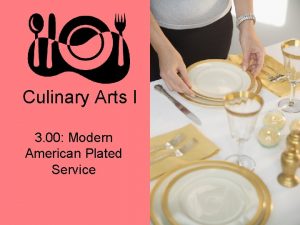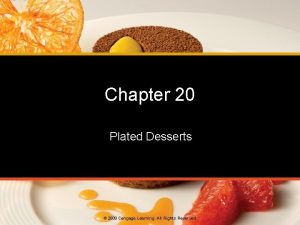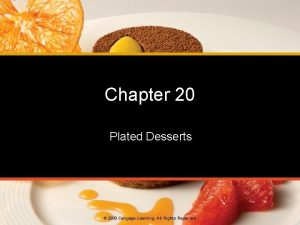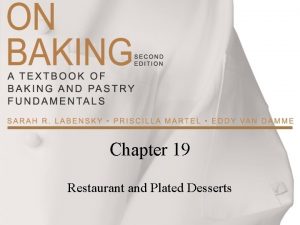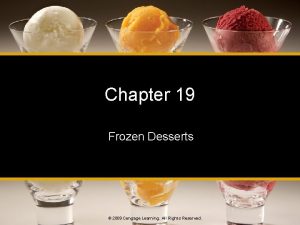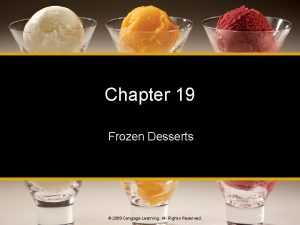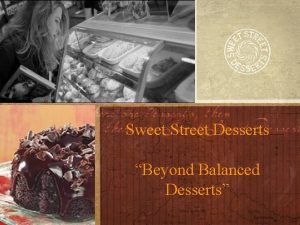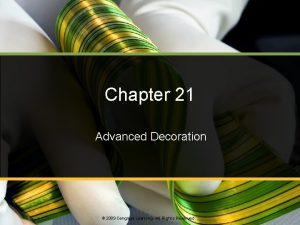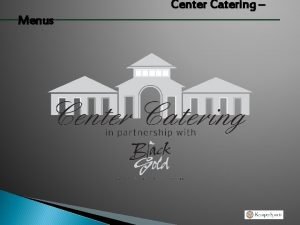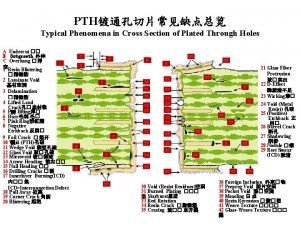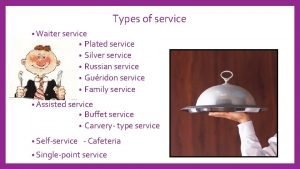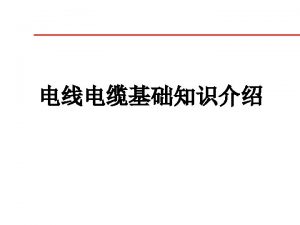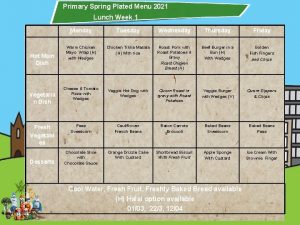Chapter 20 Plated Desserts 2009 Cengage Learning All




















- Slides: 20

Chapter 20 Plated Desserts © 2009 Cengage Learning. All Rights Reserved.

Introduction: The Plated Desserts CHAPTER • Mainly served at restaurants and hotels, after a course meal • Consist of several components: combinations of different textures, flavors and temperatures • May require a la minute assembly • Leaves the final impression of the entire dining experience © 2009 Cengage Learning. All Rights Reserved. 20

The Plated Dessert • Categories of Plated Desserts – Frozen Dessert • Two Main types: Churned and Still-Frozen • Can be purchased from pastry purveyors and local ice cream distributors • Best to made at the site – requires ice cream machine • Variations of shapes and textures • Common Frozen Desserts: Coupe, Bombe Glace, Vacherin, Profiteroles, Baked Alaska © 2009 Cengage Learning. All Rights Reserved. CHAPTER 20

The Plated Dessert • Categories of Plated Desserts – Warm and Hot Desserts • Examples of Hot Desserts: – Classic Soufflé – Fruit Crisps, Cobblers and Turnovers – Fried Pastries: Fritters and Donuts – Tableside Flambé: Crepes Suzette, Bananas Foster • Requires only basic techniques • Great impression on customers © 2009 Cengage Learning. All Rights Reserved. CHAPTER 20

The Plated Dessert CHAPTER • Categories of Plated Desserts – Custard and Cream Based Desserts • Variations of Crème Anglaise – Crème Brûlèe – Crème Caramel – Pastry Cream – Sabayon – Panna Cotta – Bread pudding • Some needs specialized ramekins or molds • Flavor variations easily created by infusions, extracts and pastes © 2009 Cengage Learning. All Rights Reserved. 20

The Plated Dessert • Categories of Plated Desserts – Fruits-Based Desserts • Different Method of Preparations: Fresh, Grilled, Baked, Dried and Poached • Adds seasonal aspects to the dessert – Chocolate Based Desserts • Popular uses of chocolate in desserts include: – Mousse – Classic gateau and layered cakes – Batter baked with a molten chocolate center – Tarts filled with ganache – Chocolate based custards, creams and parfaits • The most expensive to produce © 2009 Cengage Learning. All Rights Reserved. CHAPTER 20

The Plated Dessert • Categories of Plated Desserts – Cheese-Based Desserts • Main types of cheeses used in desserts include: Cream cheese / Ricotta / Cottage / Curd cheese / Fromage frais / Mascarpone / Goat cheese • Popular cheese-based desserts: – Cheesecake – Crepe with cheese filling – Soufflés – Ricotta or Goat cheese fritters • Specialize the dessert by stating origin of the cheese © 2009 Cengage Learning. All Rights Reserved. CHAPTER 20

The Plated Dessert CHAPTER 20 • The Menu – The dessert menu should complement the main course menu – Balanced menu including venue, season, style of presentation, current trends, ease of production and execution of service – Texture and temperatures diverse © 2009 Cengage Learning. All Rights Reserved.

The Plated Dessert CHAPTER 20 • The Menu – The Venue and Market • The desserts should suit to the venue of the restaurant or hotel. • Understand customer’s expectations and how much they are willing to pay for it. • What is available in the establishment also affects on the menu. (equipments, fridge/freezer space, temperature control, number of staff, etc) © 2009 Cengage Learning. All Rights Reserved.

The Plated Dessert CHAPTER 20 • The Menu – The Season – Use of fruits in season – Holidays and traditions – Winter • Tropical fruits, chocolate, nuts, alcohol, warm and Hot dessert – Spring • Berries, rhubarb, cherries, herbs. Refreshing flavors – Summer • Berries, stone fruits, melons. Light, chilled desserts. – Fall • Tree fruits, figs, squash, grapes, dried fruits, liquors, wines, spices • Flavors from holiday specialties (pumpkin, cranberry, gingerbread, etc) © 2009 Cengage Learning. All Rights Reserved.

The Plated Dessert CHAPTER 20 • The Menu – Dessert Service • Consideration on how each dessert is prepared and served • Equipment and tool limitation, storage space, refrigerator and freezer space, skill level of the staff, etc © 2009 Cengage Learning. All Rights Reserved.

The Plated Dessert • Considerations for Plated Desserts – Once the style of the menu is determined, choose the main component of the dessert first, then design the rest of the plate. – The number of components per plate ranges from two to five, depending on the style. – The shape, texture, temperature, and color of each component © 2009 Cengage Learning. All Rights Reserved. CHAPTER 20

The Plated Dessert • The Main Component – The star of the plate, highlighting the predominate ingredients – The additional components (sauce, décor, etc) are chosen based on the main component – Pies, tarts, cakes, etc… © 2009 Cengage Learning. All Rights Reserved. CHAPTER 20

The Plated Dessert • Additional Components for Plated Desserts – Sauces • Add texture, flavor, color and design • Something related to the main component • Cream-based sauce • Fruit-based sauce • Gelee • Syrup and oil © 2009 Cengage Learning. All Rights Reserved. CHAPTER 20

The Plated Dessert • Additional Components for Plated Desserts – Sauces • Cream-Based Sauces – Thickened with eggs, caramel, starch and/or chocolate – Crème Anglaise / Caramel Sauce / Chocolate Sauce • Fruit Sauces and Fruit Coulis – Fruit sauces contain some pulp from the fruit – Fruit coulis are clear and contain no pulp – Use of fresh and frozen fruit – Balance of sweetness and acid © 2009 Cengage Learning. All Rights Reserved. CHAPTER 20

The Plated Dessert • Additional Components for Plated Desserts – Sauces • Gelee – Any sweetened puree, juice and alcohol can be used – Set overnight before using – Proteolytic enzymes in fresh fruit puree • Syrups and Oils – Infusion with spices, herbs, zests and other ingredients • Techniques for Using Sauce as a Decorative Element – Drizzling, pooling, blending two colors, outlines, etc – Use of squeeze bottle © 2009 Cengage Learning. All Rights Reserved. CHAPTER 20

The Plated Dessert • Additional Components for Plated Desserts – Foams • A dispersion of gas throughout a continuous solid phase (which may be liquid) • A trend of using extremely light and delicate foam on plated desserts – Tuile • Malleable, crisp and thin cookies • Tuile batter is spread over stencil or piped on parchment paper or silicon mat • Baked until golden, formed while still warm © 2009 Cengage Learning. All Rights Reserved. CHAPTER 20

The Plated Dessert • Additional Components for Plated Desserts – Fruits • Fresh, cooked, dried, candied and frozen fruits • Availability – Flowers an Herbs • Can be used fresh, dried or infused – Chocolate and Sugar Decoration • Experience and equipments are required • Refer to Chapter 21 and 22 © 2009 Cengage Learning. All Rights Reserved. CHAPTER 20

The Plated Dessert • Mise en Place and Service – Preparation of all necessary ingredients an equipments for cooking – Efficiency and organization of the preparation – Monitoring quality © 2009 Cengage Learning. All Rights Reserved. CHAPTER 20

Conclusion • The final course of the meal that should complement previous courses • Must have a knowledge of pastry arts and ability to plan and present artfully • Organization of the workplace, production schedule and execution of service are needed to implement ideas © 2009 Cengage Learning. All Rights Reserved. CHAPTER 20
 2009 delmar cengage learning
2009 delmar cengage learning 2009 delmar cengage learning
2009 delmar cengage learning Introduction to medical terminology chapter 1
Introduction to medical terminology chapter 1 2009 delmar cengage learning
2009 delmar cengage learning Chapter 6 the skeletal system answer key
Chapter 6 the skeletal system answer key 2009 delmar cengage learning
2009 delmar cengage learning Chapter 10 cultural diversity
Chapter 10 cultural diversity Structure of salads
Structure of salads Modern american plated
Modern american plated Categories of plated dessert
Categories of plated dessert The human respiratory system chapter 7 handout
The human respiratory system chapter 7 handout Cengage learning heart diagram
Cengage learning heart diagram Cengage learning heart diagram
Cengage learning heart diagram South-western cengage learning
South-western cengage learning Cengage learning heart diagram
Cengage learning heart diagram Cengage learning australia
Cengage learning australia Whille
Whille Cengage learning
Cengage learning Wadsworth cengage learning
Wadsworth cengage learning Cengage learning
Cengage learning Cengage learning plant cell
Cengage learning plant cell







